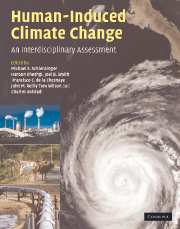Book contents
- Frontmatter
- Contents
- List of contributors
- Preface
- Part I Climate system science
- Part II Impacts and adaptation
- 9 Dynamic forecasts of the sectoral impacts of climate change
- 10 Assessing impacts and responses to global-mean sea-level rise
- 11 Developments in health models for integrated assessments
- 12 The impact of climate change on tourism and recreation
- 13 Using adaptive capacity to gain access to the decision-intensive ministries
- 14 The impacts of climate change on Africa
- Part III Mitigation of greenhouse gases
- Part IV Policy design and decisionmaking under uncertainty
- Index
- Plate section
- References
14 - The impacts of climate change on Africa
from Part II - Impacts and adaptation
Published online by Cambridge University Press: 06 December 2010
- Frontmatter
- Contents
- List of contributors
- Preface
- Part I Climate system science
- Part II Impacts and adaptation
- 9 Dynamic forecasts of the sectoral impacts of climate change
- 10 Assessing impacts and responses to global-mean sea-level rise
- 11 Developments in health models for integrated assessments
- 12 The impact of climate change on tourism and recreation
- 13 Using adaptive capacity to gain access to the decision-intensive ministries
- 14 The impacts of climate change on Africa
- Part III Mitigation of greenhouse gases
- Part IV Policy design and decisionmaking under uncertainty
- Index
- Plate section
- References
Summary
Background
Many scientists, economists, and policymakers agree that the world is facing a threat from climate warming (IPCC, 2001a). The degree of the impact and its distribution is still debated. The current evidence suggests that countries in temperate and polar locations may benefit from small economic advantages because additional warming will benefit their agricultural sectors (Mendelsohn et al., 2000; Mendelsohn and Williams, 2004). Many countries in tropical and subtropical regions are expected to be more vulnerable because additional warming will affect their marginal water balance and harm their agricultural sectors (IPCC, 2001b; Tol, 2002; Mendelsohn and Williams, 2004). However, little empirical research has been done on tropical countries, so that little is known about the extent of these damages. The problem is expected to be most severe in Africa, and especially sub-Saharan Africa, where the people are poor, temperatures are high, precipitation is low, technological change has been slow, and agriculture dominates domestic economies. African farmers have adapted to their current climates, but climate change may well force large regions of marginal agriculture out of production in Africa.
The agriculture sector is a major contributor to the current economy of most African countries. Across the continent, agriculture averages 21% of gross domestic product (GDP) but this value ranges from 10% to 70% of the GDP of individual countries (Mendelsohn et al., 2000).
- Type
- Chapter
- Information
- Human-Induced Climate ChangeAn Interdisciplinary Assessment, pp. 161 - 166Publisher: Cambridge University PressPrint publication year: 2007
References
- 1
- Cited by



